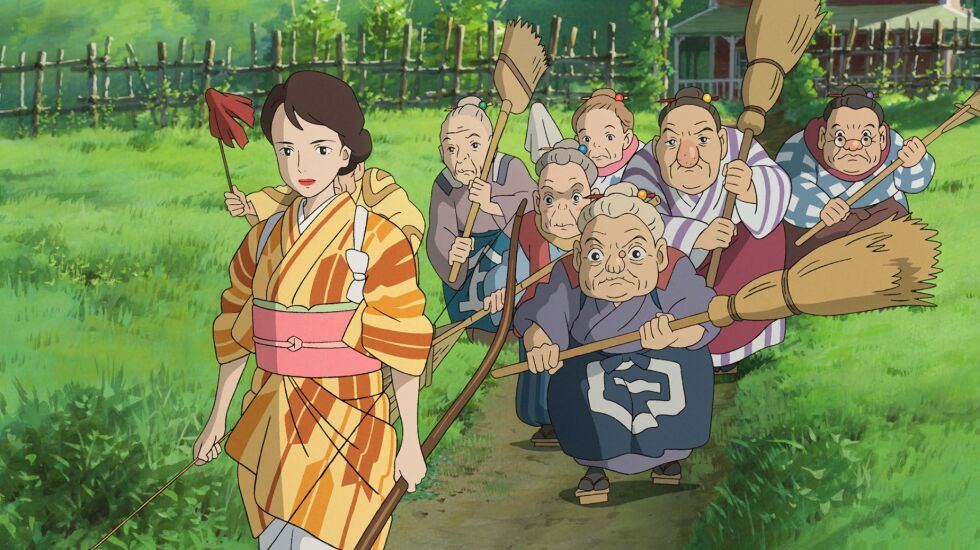
Like many a great artist, the legendary Japanese filmmaker and Studio Ghibli co-founder Hayao Miyazaki has retired more than once, only to be drawn back into the game, much to the benefit of legions of fans. The 82-year-old Miyazaki delivered a “final” film multiple times over the years, most recently with the 2013 masterpiece “The Wind Rises,” which seemed like the perfect farewell — but it’s our joy to report Miyazaki has gifted the world with another film, the elegant, beautiful, soaring and deeply personal “The Boy and the Heron.”
While this period-piece, existential fantasy adventure doesn’t rank with the absolute finest entries in Miyazaki’s iconic canon, it’s still one of the most inventive and creative films, animated or otherwise, of the year.
Rendered in screen-popping cel animation, with layers of hand-painted images on film atop painted backgrounds, and inspired by elements of Miyazaki’s experiences as a youth growing up in a time of war and fear and great uncertainty, “The Boy and the Heron” is at times haunting but also inspirational and uplifting and even flat-out funny in parts, as writer-director Miyazaki explores grand themes of loss and grief and spiritual growth in a decidedly trippy fashion.
It also contains a great deal of Miyazaki’s usual pessimism about certain facets of human nature. (The film’s original title was more blunt and far less innocent sounding. It was called “How Do You Live?” and aren’t we asking ourselves that question in one fashion or another every day?)
Set against the backdrop of World War II, “The Boy and the Heron” is centered on Mahito Maki, a 12-year-old boy (a rare male protagonist for Miyazaki) who is haunted by the horrific death of his mother in a Tokyo hospital fire, depicted here in a sequence that’s terrifying and yet ultimately spiritually resonant. (Soma Santoki voices Mahito in the subtitled Japanese version I saw; at other screenings, the voices are dubbed in English by Christian Bale, Robert Pattinson, Florence Pugh and other stars.)

Sometime later, Mahito’s father, Shoichi Maki (Takuya Kimura), who runs an air munitions factory, has married his late wife’s younger sister, Natsuko (Yoshino Kimura). She is pregnant with their child, and the family moves to an estate in the countryside that was owned by Shoichi’s late mother. With Shoichi consumed with keeping the factory up to speed, young Mahito finds himself isolated and bullied at school, and feeling lost on the estate grounds, as Natsuko tries (and largely fails) to connect with him while a gaggle of hilariously drawn, tiny old maids who have worked there forever flutter about.
Enter the Grey Heron (Masaki Suda), who at first is a persistent irritation taunting Mahito with cryptic statements about his deceased mother, claiming she is waiting for him to rescue her, but is eventually revealed to be a gnarly old man but then becomes the Grey Heron again because this is Miyazaki-land. The Grey Heron becomes Mahito’s guide and protector — though we’re not sure he can be trusted — as Mahito enters a parallel dimension filled with fantastical and visually jarring creatures. They range from the magical and delightful to the downright scary, including giant, man-eating parakeets who march in formation like soldiers in a fascist country and are led by the Parakeet King himself (Jun Kunimura), and flocks of cheerful, chattering white puffballs known as warawara, who can inflate like balloons and float into the sky and transcend into humans in the real world — if they can avoid being consumed by hungry pelicans. (And you think YOUR edibles are powerful.)
More important to Mahito’s journey is Lady Himi (voiced by the J-Pop star Aimyon), a heroic and magical “fire maiden” who bears a strong resemblance to Mahito’s mother. It’s Lady Himi who becomes Mahito’s true guide in more ways than one, helping him navigate the labyrinthine pathways of this underground world and teaching him lessons that will continue to reverberate if and when Mahito can make his way back to his real-world home. The journey eventually brings Mahito into contact with his Grand Uncle (Shohei Hino), who runs this world and tells Mahito only someone with his bloodlines and a lack of malice can take over the reins, and he’s starting to believe that Mahito might be the right person for the job. Mahito has some life-changing, perhaps world-shattering, choices to make, and no matter which course he takes, we know he’ll have a different view of how to live when the odyssey draws to a close.
The animation in “The Boy and the Heron” is amazing, whether it’s an epic set-piece featuring multitudes of magical creatures, or something as simple as Mahito being served a piece of bread ladled with butter and jam. Perhaps this is really and truly the final film for Hayao Miyazaki. If so, it’s a lovely and powerful and graceful end note.







